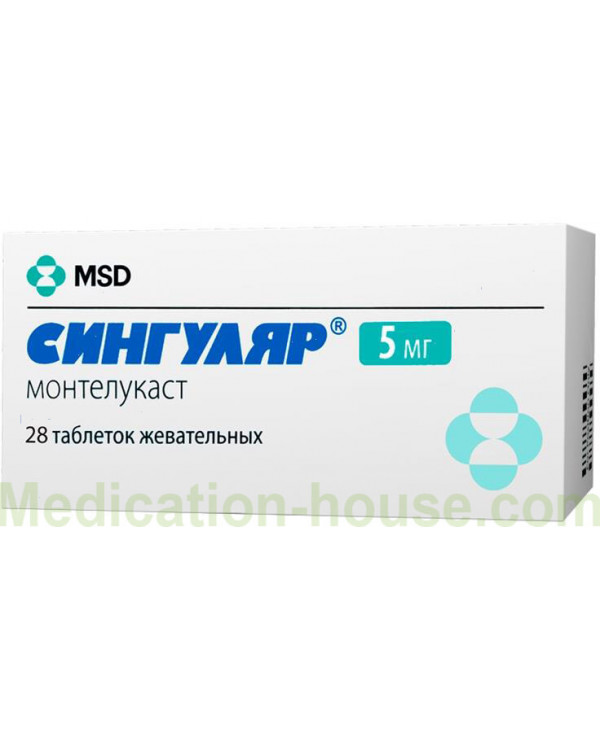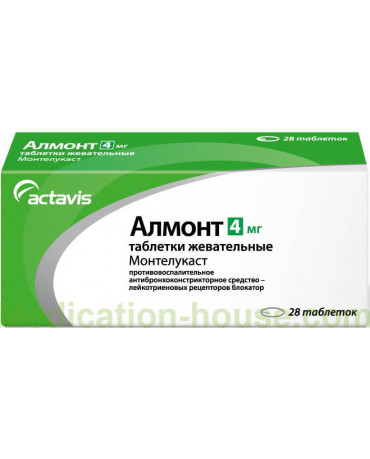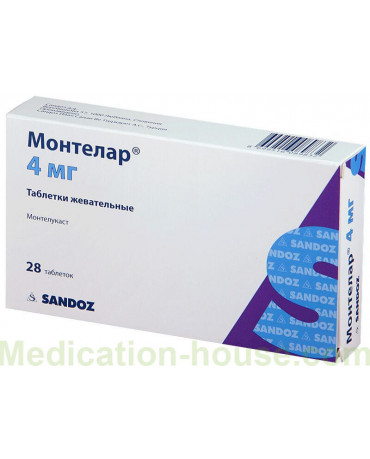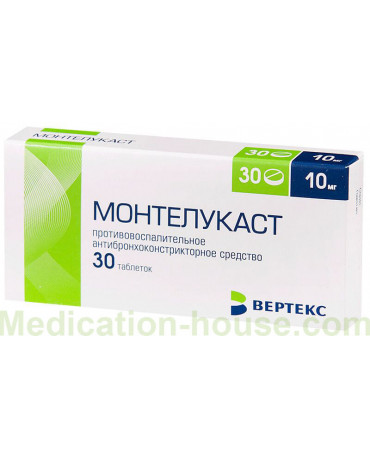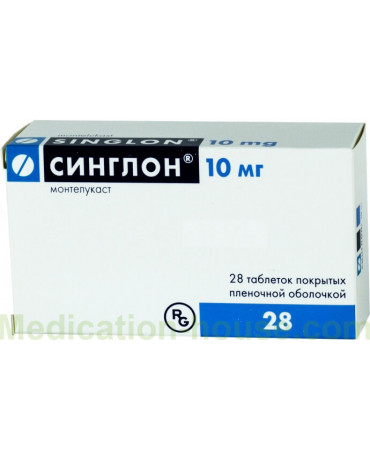Singulair instruction
You can buy Singulair here
Singulair is a blocker of leukotriene receptors, an anti-bronchospastic anti-inflammatory drug.
Release form and composition
Dosage forms of Singulair:
chewable tablets: biconvex, pink in color, engraved with SINGULAIR on one side, on the other: for oval tablets - MSD 711, for round tablets - MSD 275 (7 pieces each in a blister, in a cardboard bundle of 1, 2 or 4 blisters);
1 chewable tablet contains:
active substance: montelukast sodium - 4.16 mg or 5.2 mg, which corresponds to 4 mg or 5 mg of free acid;
auxiliary components: cherry flavoring, mannitol, hyprolose (hydroxypropyl cellulose), croscarmellose sodium, microcrystalline cellulose, iron oxide red, magnesium stearate, aspartame.
Pharmacodynamics
Cysteinyl leukotrienes (LTC4, LTD4, LTE4) are strong inflammatory mediators, eicosanoids, which can be secreted by various cells (including eosinophils and mast cells). These important pro-asthmatic mediators are able to bind to cysteinyl leukotriene receptors. CysLT1 receptors (cysteinyl leukotriene receptors of type I) are present in the human respiratory tract (including macrophages and smooth muscle cells of the bronchi) and other proinflammatory cells (including eosinophils and some myeloid stem cells).
Cysteinyl leukotrienes correlate with the pathophysiology of allergic rhinitis and bronchial asthma. The reason for the development of symptoms of allergic rhinitis is the release of cysteinyl leukotrienes from the pro-inflammatory cells of the nasal mucosa during the early and late phases of the allergic reaction, which develops when exposed to the allergen. An intranasal test with cysteinyl leukotrienes showed an increase in the resistance of the airways of the nose and symptoms of nasal obstruction. In asthma, the following leukotriene-mediated effects develop: an increase in the number of eosinophils, an increase in vascular permeability, an increase in mucus secretion, and bronchospasm.
When taken orally, montelukast has high activity and significantly improves inflammation in bronchial asthma. According to pharmacological and biochemical analysis, the substance selectively and with high affinity binds to CysLT1 receptors, but it does not interact with other pharmacologically important receptors in the respiratory tract (cholinergic, prostaglandin or β-adrenergic receptors). Due to its ability to bind to CysLT1 receptors, montelukast inhibits the physiological effect of the cysteinyl leukotrienes LTC4, LTD4 and LTE4 and does not have a stimulating effect on these receptors.
Montelukast is able to inhibit CysLT receptors in the airways, which is confirmed by its ability to block the development of bronchospasm in response to inhalation of LTD4 in patients with bronchial asthma. For relief of LTD4-induced bronchospasm, a dose of 5 mg is sufficient.
Ingestion of montelukast causes bronchodilation within 2 hours and may supplement bronchodilation caused by β2-adrenergic agonists.
When taking more than 10 mg 1 time per day, the effectiveness of montelukast does not increase.
Pharmacokinetics
After oral administration, montelukast is absorbed quickly and almost completely. The average oral bioavailability is 64%. In adult patients taking fasting 10 mg of montelukast, the maximum concentration of the substance in the blood plasma is observed after 3 hours. Taking the drug with food does not affect bioavailability and maximum concentration.
Montelukast binds to plasma proteins by more than 99%. The volume of distribution in a state of equilibrium concentration is from 8 to 11 liters.
Studies in rats with radioactively labeled montelukast revealed minimal penetration of the substance through the blood-brain barrier. In addition, 24 hours after the administration, the concentrations of the labeled drug in all other tissues were minimal.
Montelukast is actively metabolized. In the study of therapeutic doses in children and adults, the concentration of montelukast metabolites in the equilibrium state in the plasma is not determined.
In in vitro studies using human liver microsomes, it was found that cytochrome P450 isoenzymes (2C8, 2C9 and 3A4) are involved in the metabolism of montelukast. Studies have also shown that this substance in therapeutic plasma concentrations does not inhibit cytochrome P450 isoenzymes (2C9, 2C19, 1A2, 2A6, 3A4 and 2D6).
In healthy adults, the plasma clearance of montelukast averages 45 ml / min. Montelukast and its metabolites are almost completely excreted by bile, which is confirmed in studies: with oral administration of radioactively labeled Montelukast, 86% of the dose received is excreted in the feces for 5 days and less than 0.2% in urine.
The half-life of montelukast in young healthy adults is 2.7–5.5 hours. When taken orally over 50 mg, the pharmacokinetics of this substance remains almost linear. When taken in the morning and evening hours, pharmacokinetic parameters do not change. When taking more than 10 mg once a day, moderate accumulation of the active substance in the plasma is observed (approximately 14%).
The pharmacokinetics of montelukast in men and women is similar. Differences in clinically significant pharmacokinetic effects in representatives of different races were not identified.
With a single oral administration of 10 mg of montelukast, the bioavailability and pharmacokinetic profile are similar in young and elderly patients, however, in elderly people, the half-life of the substance from plasma is slightly longer.
In patients with clinical manifestations of cirrhosis and liver failure of mild or moderate severity, the metabolism of montelukast slows down. With a single dose of 10 mg, the area under the AUC pharmacokinetic curve increases by about 41%. Compared with healthy people, such patients have a slightly longer montelukast excretion time (average elimination half-life is 7.4 hours). There are no data on the pharmacokinetics of montelukast in individuals with severe hepatic insufficiency (more than 9 points on the Child-Pugh scale).
Since montelukast and its metabolites are not excreted in the urine, there is no data on the pharmacokinetics of the substance in patients with renal failure.
Indications for use
bronchial asthma - prevention and long-term treatment of adults and children from 6 years old (for chewable tablets 5 mg) or from 15 years old (for coated tablets) in order to prevent day and night symptoms of the disease, to prevent bronchospasm during physical exertion, including treatment of patients with bronchial asthma with hypersensitivity to acetylsalicylic acid;
relief of night and day symptoms of seasonal and perennial allergic rhinitis in patients older than 6 years (for chewable tablets 5 mg) or from 15 years (for coated tablets).
Contraindications
age up to 2 years;
hypersensitivity to the components of the Singulair.
Additionally for chewable tablets:
phenylketonuria;
age up to 6 years (for chewable tablets 5 mg).
The use of Singulair during pregnancy and breastfeeding is possible only if the expected effect of therapy for the mother outweighs the potential threat to the fetus or child.
Instructions for use of the Singulair: method and dosage
Tablets are taken orally, regardless of the meal, 1 time per day.
In the treatment of bronchial asthma, the drug is used in the evening, allergic rhinitis - at any time convenient for the patient. In bronchial asthma with concomitant allergic rhinitis, the patient takes a dose in the evening 1 time per day.
Recommended daily dosage of Singulair:
patients older than 15 years: 1 coated tablet - 10 mg;
children aged 6 to 14 years: 1 chewable tablet - 5 mg;
children from 2 to 5 years: 1 chewable tablet - 4 mg.
The therapeutic effect of the drug develops during the first day.
The patient needs to continue taking pills, not only with exacerbation of bronchial asthma, but also during the period when control over the symptoms of bronchial asthma is achieved.
With renal failure, mild to moderate severity of liver dysfunction, elderly patients do not need dose adjustment.
Side effects
Undesirable effects recorded in the post-registration period of the drug:
from the cardiovascular system: heart palpitations;
infectious and parasitic pathologies: upper respiratory tract infections;
from the blood coagulation system: a tendency to increase bleeding;
from the psyche: anxiety, agitation (including hostility, aggressive behavior), impaired attention, disorientation, pathological dreams, insomnia, hallucinations, psychomotor activity (including anxiety, irritability, tremor), memory impairment, somnambulism, depression, suicidal thoughts and behavior;
from the immune system: hypersensitivity reactions, including anaphylaxis; very rarely - eosinophilic liver infiltration;
from the digestive system: dyspepsia, nausea, vomiting, diarrhea, pancreatitis;
from the nervous system: drowsiness, dizziness, paresthesia or hypesthesia; very rarely - cramps;
from the respiratory system: pulmonary eosinophilia, nosebleeds;
on the part of the liver and biliary tract: increased activity of alanine aminotransferase (ALT) and aspartate aminotransferase (AST) in the blood; very rarely - hepatitis (including hepatocellular, cholestatic or mixed liver damage);
allergic reactions: urticaria, angioedema;
from the musculoskeletal system: myalgia, muscle cramps, arthralgia;
on the part of the skin and subcutaneous tissues: skin itching, rash, tendency to hematomas, erythema multiforme, erythema nodosum;
from the urinary system: in children - enuresis;
general reactions: edema, asthenia (weakness) or increased fatigue, pyrexia.
The Singulair is well tolerated in most patients, side effects usually occur in mild form and do not require discontinuation of therapy.
Overdose
In clinical studies of long-term (22 weeks) treatment of patients with bronchial asthma with a daily dose of up to 200 mg and a short (about 1 week) use of Singulair with a daily dose of up to 900 mg, no overdose symptoms were detected.
In the post-registration period and during clinical trials in children and adults with the intake of at least 1000 mg of Singulair per day, cases of acute overdose were recorded. Laboratory and clinical data indicate the comparability of the safety profiles of the drug in children, adults and elderly patients. The most common side effects (psychomotor agitation, drowsiness, abdominal pain, thirst, vomiting, headache) are consistent with the safety profile of the drug.
There is no specific information on the treatment of an overdose of Singulair. In acute overdose, symptomatic treatment is recommended. There are no data on the effectiveness of hemodialysis or peritoneal dialysis for montelukast.
special instructions
With a confirmed allergy to acetylsalicylic acid and other non-steroidal anti-inflammatory drugs (NSAIDs), their simultaneous administration with montelukast is contraindicated, since it is not possible to completely prevent bronchoconstriction caused by NSAIDs.
The Singulair is not recommended for the treatment of acute attacks of bronchial asthma. To stop attacks of bronchial asthma, the patient should always have emergency medications - inhaled short-acting beta2-agonists. During an exacerbation of asthma, you should not stop taking the drug.
When prescribing the drug, it is impossible to abruptly cancel inhaled or oral glucocorticosteroids (GCS), a gradual reduction in the dose of simultaneously used GCS is allowed under the supervision of a doctor. A sharp decrease in the dose of systemic corticosteroids can cause a rash, worsening pulmonary symptoms, the development of eosinophilia, cardiac complications and / or neuropathy, systemic eosinophilic vasculitis.
Since there is a risk of neuropsychiatric disorders against the background of the use of the Singulair, the patient should be warned about the possibility of their development and the need to immediately consult a doctor if undesirable symptoms appear.
Adult patients are advised to be careful when driving vehicles and mechanisms because of the risk of side effects in the form of dizziness and drowsiness.
Pregnancy and lactation
Clinical studies of the effects of Singulair on pregnancy have not been conducted. According to the data of post-registration use, cases of development of congenital limb defects in newborns whose mothers took the drug during pregnancy were recorded. Also, most of these women took other medications to treat bronchial asthma, so a causal relationship between the development of congenital limb defects and taking Singulair has not been established.
There are no data on the excretion of the drug with breast milk.
The use of Singulair during pregnancy and breastfeeding is possible only in cases where the potential benefit to the mother outweighs the potential risk to the fetus / baby.
Use in childhood
According to the instructions, Singulair is used in the treatment of children of the following age categories:
chewable tablets 4 mg - from 2 years;
chewing tablets 5 mg - from 6 years old;
coated tablets - from 15 years.
With impaired renal function
Dose adjustment of Singulair in patients with impaired renal function is not required.
With impaired liver function
In the treatment of persons with mild or moderate hepatic insufficiency, dose adjustment of Singulair is not required.
Use in old age
In the treatment of elderly patients, dose adjustment of Singulair is not required.
Drug interaction
The Singulair is indicated for simultaneous use with drugs intended for the prevention and long-term treatment of bronchial asthma and / or therapy for allergic rhinitis.
The recommended therapeutic dose of montelukast does not have a clinically significant effect on the pharmacokinetics of theophylline, prednisone, prednisone, terfenadine, warfarin, digoxin, oral contraceptives (norethindrone or ethinyl estradiol).
A decrease in the AUC of montelukast by approximately 40% with concomitant phenobarbital therapy does not require correction of the dosage regimen of the drug.
The drug can be prescribed in combination with paclitaxel, rosiglitazone, repaglinide and other drugs that are metabolized with the participation of the CYP2C8 isoenzyme.
The inhibitor of isoenzymes CYP2C8 and CYP2C9 gemfibrozil increases the systemic effect of montelukast exposure by 4.4 times. However, this effect is not considered clinically significant and does not require dose adjustment of montelukast.
Clinical studies have shown that as a substrate of the isoenzymes CYP2C8, CYP3A4 and CYP2C9, montelukast does not cause a therapeutically significant interaction with other CYP2C8 inhibitors, including trimethoprim, itraconazole.
With monotherapy with bronchodilators that do not provide adequate control of bronchial asthma, the use of Singulair is a reasonable complement to therapy. After the therapeutic effect of the combined treatment is achieved, the doses of bronchodilators can be gradually reduced.
Terms and conditions of storage
To store in the place protected from light and moisture at a temperature up to 30 ° C. Keep out of the reach of children.
Shelf life: chewable tablets - 2 years, coated tablets - 3 years.
Reviews
Reviews of Singulair indicate its effectiveness in the treatment of children of different ages. Among the advantages of the drug, speed, safety for health and the low probability of developing side effects are often mentioned. Reports of side effects are extremely rare.
According to doctors, the Singulair, which is a non-hormonal drug, in some cases can be a complete replacement for inhaled corticosteroids.
Terms of sell
You can buy Singulair without a prescription.

